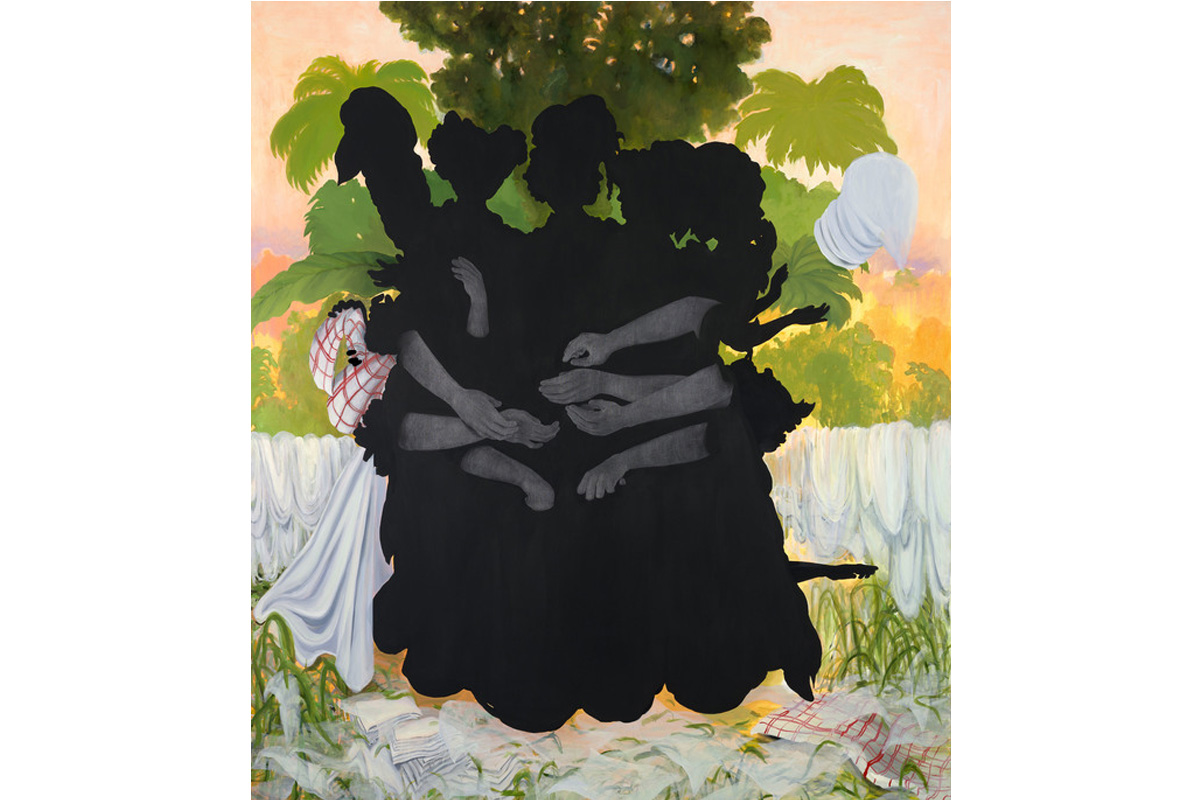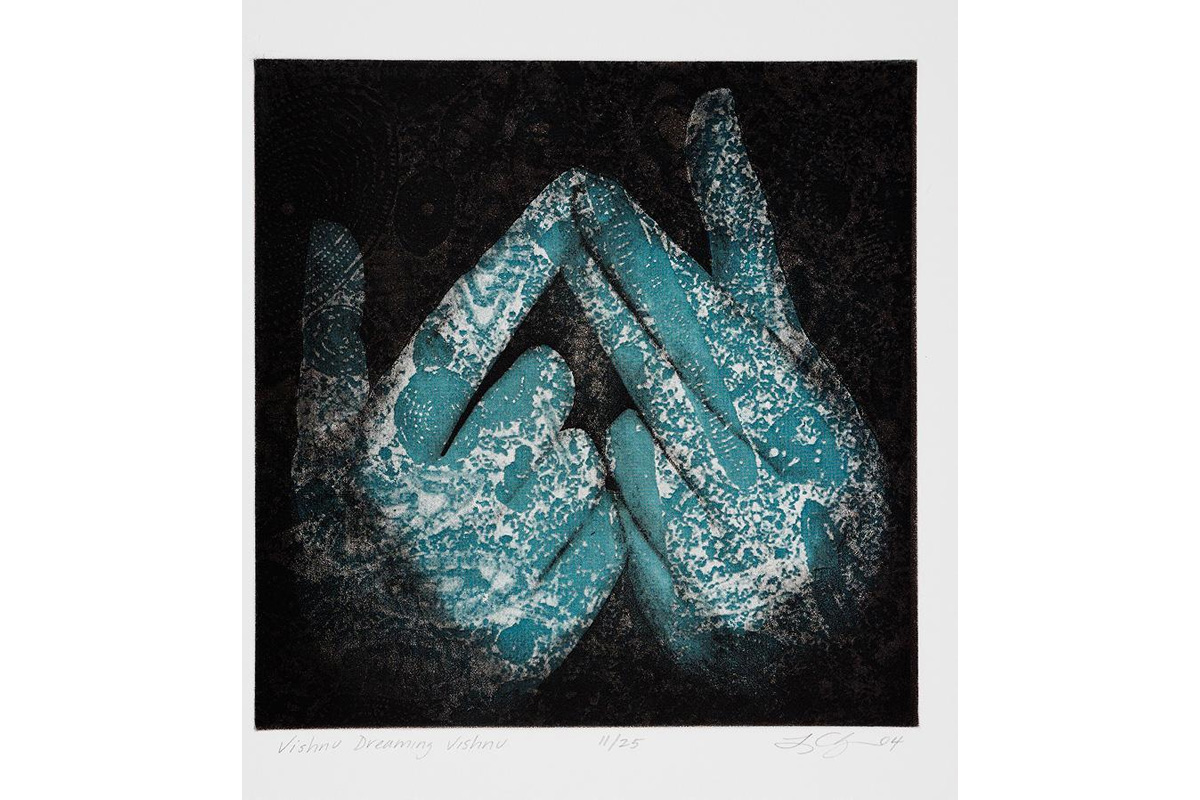
Alex Callender. American, born 1980. Oil, acrylic paint and granite on canvas. Purchased with the Dorothy C. Miller, class of 1925, Fund. Image Petegorsky/Gipe for SCMA. SC 2022.30.1
Interviewing Contemporary Artists from the SCMA Collection
Indigo Casais ’23 is an art history and English double major. Indigo is also the 2022-23 Kennedy Museum Research Fellow in Art History at SCMA, working with Emma Chubb, Charlotte Feng Ford ’83 Curator of Contemporary Art.
I’ve been lucky enough to work as a research assistant to Emma Chubb, SCMA’s curator of contemporary art, for three of my four years at Smith. One of my favorite parts of my job has been collaborating with artists on research projects, events, and exhibitions. I love being able to hear from artists about their processes and inspirations; one way I’ve been able to do this is through a series of oral history interviews with artists whose work is in the collection.
My interest in artist interviews began during my first year at Smith when I curated a display cabinet juxtaposing Romantic and contemporary prints. Two of the artists whose work I included in the cabinet were local to the Pioneer Valley: Liz Chalfin and Barry Moser. Right after the pandemic began in March 2020, I spoke with both artists over the phone. We talked about their interests in themes like nature, spirituality, and literature — interviews that we eventually published as blog posts.

Liz Chalfin. American, born 1958. Vishnu Dreaming Vishnu from the portfolio The Nature of Things, 2004. Photoetching printed in color on wove paper. Anonymous gift in honor of the artists and Zea Mays Printmaking. SC 2005.6.3.
Through these conversations, I realized the need for this kind of content at SCMA. One of the roles of the curatorial department is to gather relevant information about artworks in the collection for our object files, which are where anyone researching a piece can look to learn more about it. But more often than not, the information in these files is pretty sparse and almost always more related to an artist’s practice as a whole than to the individual object we have at SCMA. One way that we can help supplement this information is by speaking directly with the artists about their work.
In spring 2021, I conducted three more interviews with artists Joanne Leonard, Marlene McCarty, and Katy Schneider (who is also a professor at Smith!). This time, our conversations were not intended to be published on the museum’s website. Instead, they were much longer and more in-depth, and afterward, I transcribed the interviews and placed them in the object files for future researchers to consult.
This year, as part of my Kennedy Museum Research Fellowship, I have expanded this project significantly. During the spring semester, I conducted oral history interviews with five additional artists: Alex Callender (another wonderful Smith professor!), Laura Chasman, Katia Kameli, Younes Rahmoun, and Hala Schoukair (daughter of artist Saloua Raouda Choucair). Our conversations were as rich and varied as the artists’ work. Some of the things we spoke about included the relationship between visual art and archival documents; the Iranian and Indian history of Jean de La Fontaine’s Fables; and the role of portraiture in capturing everyday experiences.
!["digital collage with gold showing two figures dressed in green and red in the center right above whom fly two ducks who hold a stick to which a turtle grasps with its mouth; the black and white background shows a landscape with trees and parts of buildings to the right; the image is framed by a grey border; text at the bottom reads, in French "LA TORTUE ET LES DEUX CANARDS. Fable CXCI." [The tortoise and the two ducks. Fable CXCI.]"](/sites/default/files/oralhistory3.jpg)
Katia Kameli. French-Algerian, born 1973. Stream of Stories (Chapter 2): The Tortoise and the Two Ducks, 2016. Digital print with gold leaf on Awagami bamboo paper. Purchased with funds from the Contemporary Associates, Smith College Museum of Art. SC 2019.39.4.
These interviews have been a highlight of my work at SCMA over the past few years. I’ve really enjoyed being able to connect with an artist and have a focused conversation about one or two of their works. But the interviews also serve a few different purposes for the museum. For one, they help artists articulate any needs or concerns they have about how SCMA conserves and displays their work, which is valuable information for our collections management staff. Having more detailed context about the origins of a piece, how it was made, and where it was displayed before entering our collection is also useful for our curatorial staff and student researchers.
Hearing directly from an artist is one of the best ways to learn more about their work, and part of why I enjoy contemporary art research is the opportunity to do just that. I hope that Smith students and other researchers will be able to connect with these artists’ work in the same way I have by reading this research.
As of August 2025, the oral history project includes interviews with the following artists: Alex Callender, Laura Chasman, Sally Curcio, Jess Dugan, Mari Eastman, Florencia Escudero and Lucía Hinojosa Gaxiola (interviewed together), Emily Eveleth, Joe Feddersen, Robert Freeman, Naima Green, Deborah Jack, Julia Jo, Katia Kameli, Joyce Kozloff and Nina Yankowitz (interviewed together), Joanne Leonard, Marlene McCarty, Emma Nishimura, Sheila Pepe, Hayal Pozanti, Maggie Puckett, Younes Rahmoun, Katy Schneider, Hala Shoukair (daughter of Saloua Raouda Choucair), Gina Siepel, Barbara Takenaga, and Kelly Wang. If you’re interested in reading any of these artist interviews, you can email Emma Chubb, Charlotte Feng Ford ’83 Curator of Contemporary Art, at echubb@smith.edu to make an appointment.